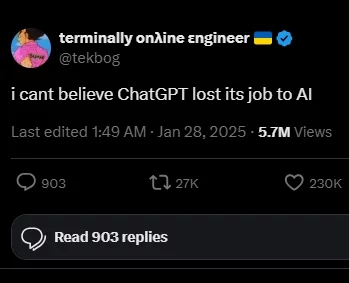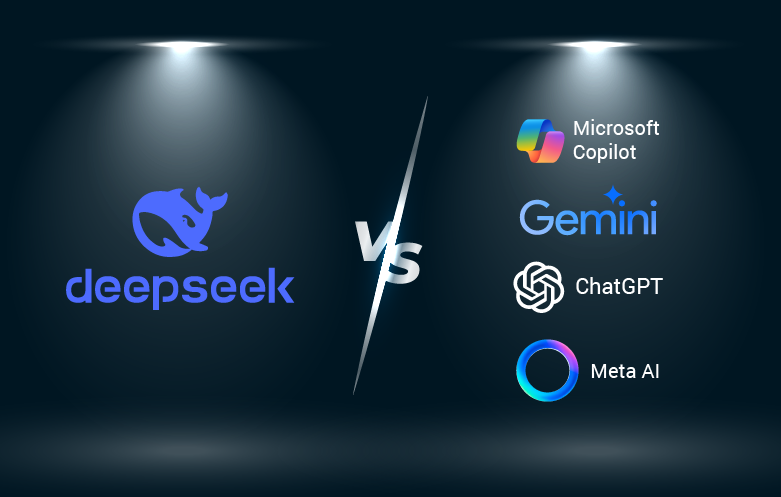NASDAQ falling over 3%!
NVIDIA, the leading chipmaker for AI applications, stocks plummeting by 11.7%!
$1 trillion wiped out in market value!
These events have unfolded in less than a week and have a common source.
But what’s causing all this?
- Regulatory changes directed by a newly formed government?
- Unprecedented catastrophic wildfires?
- Another geopolitical standoff between bordering nations?
These might be great guesses, but it’s none of these!
The answer? DeepSeek!
Don’t confuse it with Deepfake. Because it’s a resolute reality that Silicon Valley learned the hard way. While still getting to know the level of disruption this brand has caused, it has piqued interest in many ventures to foray into this area. With its open-source LLM approach and the growing demand for GenAI services, businesses are eager to explore its potential in real-world applications. However, without the right strategy and expertise, unlocking AI’s full capabilities can be challenging. That’s why it is best to partner with expert AI consulting services to efficiently navigate the complexities of AI and its applications.
The big question – What is DeepSeek?
Liang Wenfeng, head of a Chinese quant hedge fund, founded a startup, named DeepSeek, in 2023 with a vision to master the large language model landscape. Little did anyone know that this relatively obscure startup would create such large ripples within 2 years of its launch that it will shake the very foundations of not only Silicon Valley, but the Silicon Alley (NASDAQ) as well.
While DeepSeek AI turned only a few heads with its V3 LLM and its claims of outperforming major players like OpenAI, Google, and Meta, it showed promise in the field. What was most interesting about this toddler just beginning to learn knee-crawling, that everything they developed was being done at a fraction of the cost compared to its well-established runners in the market. DeepSeek’s model taps into the power of open source LLM, enabling rapid, flexible adoption and customization.
At what “fraction” you might ask! This topic has eagerly awaited a response.
The answer lies in –
How does DeepSeek challenge OpenAI?
OpenAI is valued at $157 Billion. There’s nothing particularly surprising about that, is there?
You are right! There isn’t.
What’s surprising is that the ripples DeepSeek’s AI created are riding on a meagre investment of $50 million.
This investment is merely a whisper next to the roar of OpenAI’s evaluation.
Trends don’t shout – but these statistics will surely leave you stunned:
- As of January 28, 2025, the app has been downloaded 2.6 million times and has become #1 in the Apple App Store, surpassing ChatGPT
- Most tech giants are using H100 GPUs (memory bandwidth upto 3.35 TB/s), whereas DeepSeek AI managed this feat using H800 GPUs (memory bandwidth of 2 TB/s), a 32% lower memory bandwidth
- OpenAI charges $15 per million input tokens for its o1 models, while DeepSeek R1 offers the same service at just $0.55 per million tokens
DeepSeek R1 is approximately 86.35% cheaper than OpenAI, making it a significantly more affordable option for AI processing, currently. – INDMoney
What’s even more remarkably staggering is that DeepSeek claims a 97% success rate delivering results on par with OpenAI’s O1, but at 1/30th of what it would cost using the recently dethroned monarch of the tech industry.
If OpenAI has taken such a hit, imagine how profound the toll would have been on the other players in the industry.
Now let’s find out –
What’s the difference between DeepSeek and its competitors?
| Aspects | Other LLMs | DeepSeek |
|---|---|---|
| Resource efficiency | GPT-4 requires significant computational power | Optimized for resource efficiency |
| Generative capabilities | Gemini (previously known as BERT) is not designed for text generation | Capable of both understanding and generation tasks |
| Domain adaptability | GPT struggles with highly specialized tasks without minimally intensive fine-tuning | It is designed to easily fine-tune and customize for niche domains |
| Cost efficiency | OpenAI’s o1 and Meta’s Llama 3.1 incur a significant cost | R1 is 95% cheaper as compared to the industry giants |
| Accessibility | $20/month fee to talk to OpenAI o1 | Free to use via the app |
| Training efficiency | More than $100 million spent to train OpenAI’s GPT-4 | $6 million on training, far less in comparison to expense by tech titans |
| Efficiency vs. scaling | Reliance on high-end hardware for scaling needs that increase costs | Leverages computational power to deliver state-of-the-art performance |

Why DeepSeek R1 is a game changer?
We talked about the breaking news headlines about the chipsets, the computational efficiencies, and the stock crashes. But what do they actually mean in a quantity and quality driven world? Let’s critically analyze these headlines.
Why DeepSeek’s architectural efficiency is challenging AI norms?
OpenAI contains about a trillion parameters and activates nearly all of them while replying to queries. Conversely, DeepSeek contains 671 billion parameters but activates only 37 billion per query – a mere 5.5% of its total capacity.
This means that DeepSeek yielded:
- Dramatically reduced computational costs per query
- Lower energy consumption
- Faster response times without sacrificing accuracy

The hidden ace:
What it translates into for emerging players in the field is that they don’t have to worry about the traditional brute-force scaling and prioritize on efficiency-driven architectures.
Why are heads turning for DeepSeek’s use of H800 instead of H100?
Working with H800 was considered to be a limitation since it was a 32% reduction on the memory bandwidth, which meant significant constraints on data transfer speeds. This would have had a great impact on AI model performance as well as training efficiency.
Yet, DeepSeek turned this hurdle into a stepping stone by:
- Advanced memory management techniques
- Optimized data flow architectures
- Innovative parameter scheduling

The edge factor:
Technocrats have now realized that optimizing for efficiency is a better alternative than mustering raw power. Strategic hardware utilization can outperform brute-force reliance on high-bandwidth GPUs.
How should we read into the NVIDIA stock crash with supply chain in view?
The notion, widely popular till a few days ago, was that the more powerful the AI chip, more revolutionary the AI tech can be. However, the newfound streak of brilliance from DeepSeek forced a re-evaluation of the entire AI chip supply chain. The murmur amongst the budding AI ventures is about if the latest and expensive GPUs are a must-have or an unnecessary overhead cost.
This event has led to:
- Increased interest in mid-range AI accelerators
- New focus on optimization over raw computing power
- Emerging market opportunities for alternative chip manufacturers
The game-changer: Smaller players can re-think the need to invest heavily into the cutting-edge GPUs and focus on the adoption of alternative accelerators and smarter optimization. Given DeepSeek’s revolutionary cost and efficiency advantages, businesses across sectors can look to incorporate these insights into their digital supply chain for better resource allocation and faster delivery cycles. Leveraging GenAI services, which provide cutting-edge generative AI capabilities, businesses are set to revolutionize their operational models with unprecedented efficiency.
“The world’s first trillionaires are going to come from somebody who masters AI and all its derivatives and applies it in ways we never thought of” – Mark Cuban, American businessman and television personality
The path leading to democratization of AI!
Any technology will better serve humanity when it is put to good use that helps the common people. Aluminum was more expensive than gold before the Hall–Héroult extraction process was invented. DeepSeek did to AI what this process did to Aluminum extraction cost.
The cost structure has been impacted so much so that:
- Countries with limited AI infrastructure can now participate in advanced AI development
- Universities can run advanced AI research programs at a fraction of the previous cost
- AI implementation becomes feasible for companies with modest budgets
So much has happened within the last week and it’s aftershocks are yet to be felt.
Is this really the dawn of a new AI era?
In the 1984 cult-classic, The Terminator, director James Cameron envisioned a post-apocalyptic world in the future where AI has overtaken the world and there is a raging war between intelligent machines and surviving humans. However, with DeepSeek’s achievements, we might witness a war between AI-tech giants, hopefully not in the same domain and intensity, fighting for the metaphorical throne for excellence and supremacy in the realm of large language modules.
The Abacus was invented around 2500 BCE. The time lapse between that and the first computer is around 4444 years. The first simple chatbot came into being 41 years after that. ChatGPT was launched 25 years later. Now we have DeepSeek within 3 years of that. The window of progression between the previous groundbreaking tech to the next one is narrowing by staggering proportions. Who knows what breakthrough we will see in the next month, or maybe the next week?









